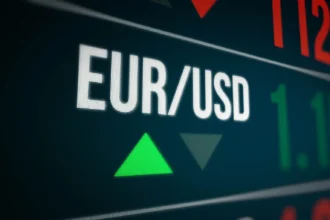1. Gold Prices Hold Near Record Levels as Investors Brace for Trump’s Tariff Announcement
Gold prices have continued their upward trend, reaching new all-time highs on Tuesday and holding steady as investors await crucial details about U.S. President Donald Trump’s much-anticipated tariff announcement. Spot gold saw an impressive 0.6% rise, reaching $3,128.62 an ounce by 1024 GMT. U.S. gold futures also posted gains of 0.5%, trading at $3,163.00.
The precious metal has become a popular investment choice amid rising economic and geopolitical risks. With Trump’s new tariffs looming large, many investors have turned to gold as a hedge against uncertainty. Notably, gold prices have surged more than $400 since Trump took office, reflecting a broader trend of increasing demand for safe-haven assets.
Gold hit its record peak of $3,148.88 on Tuesday, a clear indicator that investors are seeking stability as concerns grow about the potential impact of Trump’s tariffs on the global economy.
2. Trump’s “Liberation Day” Tariff Plan: What’s at Stake?
U.S. President Donald Trump has been promoting April 2 as “Liberation Day,” the day when he is set to announce a new round of sweeping tariffs targeting multiple countries. This tariff announcement will take place at a White House Rose Garden event at 2000 GMT, and investors are watching closely to understand the potential consequences of these measures.
The tariffs are expected to affect a wide range of goods from various countries, and experts are concerned that these moves could slow economic growth, escalate trade disputes, and potentially lead to stagflation. If the tariffs are more severe than expected, they could add to existing inflationary pressures, worsening the outlook for both the U.S. and global economies.
Han Tan, Chief Market Analyst at Exinity Group, noted that gold could surge to even higher levels if Trump’s announcement pushes markets into a stagflation or recession scenario. As of now, there is considerable uncertainty around the full scope of the tariffs, which has contributed to gold’s rally.
3. Gold’s Resilience Amid Economic Concerns
The rise in gold prices is not just a reaction to Trump’s impending tariff announcement but also a broader reflection of the economic climate. The U.S. economy has shown signs of slowing down in recent months, with reports of contracting manufacturing activity and declining job openings. The Institute for Supply Management’s survey from Tuesday painted a pessimistic picture of U.S. business conditions, further fueling concerns about an economic slowdown.
UBS’s base case forecast for gold in 2025 is set at $3,200 per ounce. However, if the economic slowdown intensifies, the bank’s upside case sees gold potentially reaching $3,500 an ounce. Such a scenario would likely materialize if Trump’s tariffs spark further economic turmoil and undermine investor confidence in global growth.
Gold’s rise is also seen as a reflection of broader fears about the U.S. Federal Reserve’s next steps. Analysts have pointed out that while gold may outperform other metals, this trend could reverse if the Fed decides to raise interest rates to combat inflation. However, with inflation concerns already rising, it seems that gold will continue to be an outperformer in the precious metals complex in the short term.
4. Other Precious Metals Reflect Market Uncertainty
While gold continues to dominate the headlines, other precious metals are also benefiting from the prevailing economic and geopolitical risks. Silver, another popular safe-haven asset, saw a 0.8% increase, reaching $33.99 per ounce. Platinum, while less volatile than gold and silver, remained steady at $978.90. Palladium also saw a modest 0.2% increase, trading at $985.80.
These metals are benefiting from the same factors driving gold’s performance, including concerns over inflation, potential trade wars, and economic slowdown. However, gold remains the standout performer due to its established reputation as a safe-haven asset during times of uncertainty.
5. How Trump’s Tariff Announcement Could Impact the Broader Markets
Trump’s tariff plans are likely to have far-reaching consequences on global markets. If the tariffs are imposed as expected, they could drive up costs for businesses, reduce consumer spending, and disrupt global supply chains. These factors could weigh heavily on economic growth and contribute to inflationary pressures.
The tariff announcement could also affect other financial markets, including equities, bonds, and foreign exchange. Stock markets, already under pressure from global trade tensions, are expected to react negatively to the announcement, while the U.S. dollar could experience increased volatility depending on the scale of the tariffs.
In this uncertain environment, gold’s appeal as a safe-haven asset is likely to continue. Investors are expected to flock to gold, which historically performs well during times of economic and geopolitical instability.
Frequently Asked Questions (FAQs)
Q1: Why are gold prices rising?
Gold prices are rising due to increasing investor concerns about economic and geopolitical uncertainties, especially in light of U.S. President Trump’s upcoming tariff announcement. Gold is traditionally viewed as a safe-haven asset during times of market volatility.
Q2: What is “Liberation Day” in relation to Trump’s tariffs?
“Liberation Day” is the day that President Trump is set to announce a new round of tariffs on foreign goods, which is expected to affect global trade. The tariffs are seen as a key part of Trump’s economic policy to address trade imbalances and encourage domestic manufacturing.
Q3: How will Trump’s tariffs impact the global economy?
Trump’s tariffs could potentially slow economic growth by raising the cost of imports, which may lead to higher prices for consumers and businesses. The tariffs could also escalate trade disputes, contributing to broader economic uncertainty and potentially triggering a recession.
Q4: Why is gold considered a safe-haven asset?
Gold is considered a safe-haven asset because it tends to retain its value during times of economic or geopolitical instability. Investors often flock to gold as a store of value when other assets, like stocks or bonds, experience volatility.
Q5: How high can gold prices go in 2025?
Analysts have forecast that gold prices could reach as high as $3,500 per ounce in 2025, particularly if global economic conditions worsen due to factors like Trump’s tariffs, inflation, or a potential recession.
Q6: What impact will Trump’s tariffs have on other metals?
While gold is benefiting from the uncertainty around Trump’s tariffs, other metals like silver, platinum, and palladium are also seeing price increases. However, gold remains the standout performer due to its strong position as a safe-haven asset.
Disclaimer
The content provided in this article is for informational purposes only and does not constitute financial advice. The information in this post is based on publicly available data and is subject to change. Please consult with a qualified financial advisor before making any investment decisions. The author and publisher are not responsible for any financial losses incurred as a result of following the content provided in this blog post.



